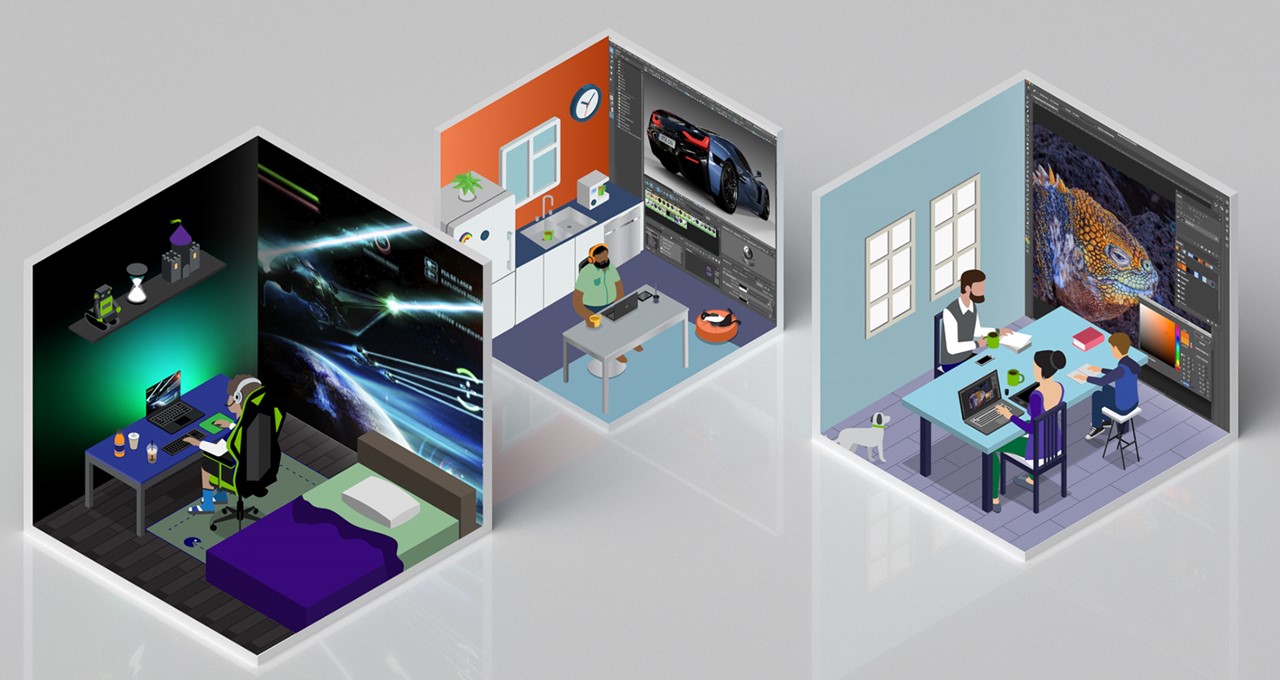For many organizations, the coronavirus pandemic has created a permanent shift in how their employees work. From now on, they’ll have the option to collaborate at home or in the office.
NVIDIA is giving these millions of professionals around the world a boost with a new version of our virtual GPU software, vGPU July 2020. The software adds support for more workloads and is loaded with features that improve operational efficiencies for IT administrators.
GPU virtualization is key to offering everyone from designers to data scientists a flexible way to collaborate on projects that require advanced graphics and computing power, wherever they are.
Employee productivity was the primary concern among organizations addressing remote work due to the COVID-19 pandemic, according to recent research by IDC. When the market intelligence firm interviewed NVIDIA customers using GPU-accelerated virtual desktops, it found organizations with 500-1,000 users experienced a 13 percent increase in productivity, resulting in approximately more than $1 million in annual savings.
According to Alex Herrera, an analyst with Jon Peddie Research/Cadalyst, “In a centralized computing environment with virtualized GPU technology, users no longer have to be tied to their physical workstations. As proven recently through remote work companies can turn on a dime, enabling anywhere/anytime access to big data without compromising on performance.”
Expanded Support in the Data Center and Cloud with SUSE
NVIDIA has expanded hypervisor support by partnering with SUSE on its Linux Enterprise Server, providing vGPU support on its kernel-based virtual machine platform.
Initial offerings will be supported with NVIDIA Virtual Compute Server software, enabling GPU virtualization for AI and data science workloads. This will expand hypervisor platform options for enterprises and cloud service providers that are seeing an increased need to support GPUs.
“Demand for accelerated computing has grown beyond specialized HPC environments into virtualized data centers,” said Brent Schroeder, global chief technology officer at SUSE. “To ensure the needs of business leaders are met, SUSE and NVIDIA have worked to simplify the use of NVIDIA virtual GPUs in SUSE Linux Enterprise Server. These efforts modernize the IT infrastructure and accelerate AI and ML workloads to enhance high-performance and time-sensitive workloads for SUSE customers everywhere.”
Added Support for Immersive Collaboration
NVIDIA CloudXR technology uses NVIDIA RTX and vGPU software to deliver VR and augmented reality across 5G and Wi-Fi networks. vGPU July 2020 adds 120Hz VSync support at resolutions up to 4K, giving CloudXR users an even smoother immersive experience on untethered devices. It creates a level of fidelity that’s indistinguishable from native tethered configurations.
“Streaming AR/VR over Wi-Fi or 5G enables organizations to truly take advantage of its benefits, enabling immersive training, product design and architecture and construction,” said Matt Coppinger, director of AR/VR at VMware. “We’re partnering with NVIDIA to more securely deliver AR and VR applications running on VMware vSphere and NVIDIA Quadro Virtual Workstation, streamed using NVIDIA CloudXR to VMware’s Project VXR client application running on standalone headsets.”
The latest release of vGPU enables a better user experience and manageability needed for demanding workloads like the recently debuted Omniverse AEC Experience, which combines Omniverse, a real-time collaboration platform, with RTX Server and NVIDIA Quadro Virtual Workstation software for the data center. The reference design supports up to two virtual workstations on an NVIDIA Quadro RTX GPU, running multiple workloads such as collaborative, computer-aided design while also providing real-time photorealistic rendering of the model.
With Quadro vWS, an Omniverse-enabled virtual workstation can be provisioned in minutes to new users, anywhere in the world. Users don’t need specialized client hardware, just an internet-connected device, laptop or tablet, and data remains highly secured in the data center.
Improved Operational Efficiency for IT Administrators
New features in vGPU July 2020 help enterprise IT admins and cloud service providers streamline management, boosting their operational efficiency.
This includes cross-branch support, where the host and guest vGPU software can be on different versions, easing upgrades and large deployments.
IT admins can move quicker to the latest hypervisor versions to pick up fixes, security patches and new features, while staggering deployments for end-user images.
Enterprise data centers running VMware vSphere will see improved operational efficiency by having the ability to manage vGPU powered VMs with the latest release of VMware vRealize Operations.
As well, VMware recently added Distributed Resource Scheduler support for GPU-enabled VMs into vSphere. Now, vSphere 7 introduces a new feature called “Assignable Hardware,” which enhances initial placement so that a VM can be automatically “placed” on a host that has exactly the right GPU and profile available before powering it on.
For IT managing large deployments, this means reducing deployment time of new VMs to a few minutes, as opposed to a manual process that can take hours. As well, this feature works with VMware’s vSphere High Availability, so if a host fails for any reason, a GPU-enabled VM can be automatically restarted on another host with the right GPU resources.
Availability
NVIDIA vGPU July 2020 release is coming soon. Learn more at nvidia.com/virtualization and watch this video.
